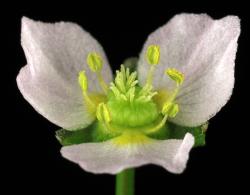- Taxon
- Gallery
Perennial, rhizome short; leaves erect (rarely floating or submerged)) from a basal rosette 0.5–1.2 m tall. Leaves long, petiolate; lamina 60–260 mm long, 15–85 mm wide, lanceolate, elliptic, narrow-elliptic, oblanceolate, base cuneate, apex sub-acute to acuminate, margin entire. Petioles 55–260 mm long, 2.5–6.0 mm wide, D-shaped to more or less terete, septate. Inflorescence a whorled panicle of 3–6(–7) verticels, pyramidal, bracteate, 190–750 mm tall, 190–500 mm wide. Flowers 7.0–12 mm diameter, pedicels terete, 10–45 mm long, glabrous. Sepals green, 2.5–3.0 mm long, ovate. Petals pale pink or lilac with a yellow spot at the base, 4.0–6.0 mm long, 5.0–6.4 mm wide, broadly elliptic to rhombic, apices acute or acuminate, sometimes notched, margin entire to irregularly sub-dentate. Stamens 6, filaments membranous, 1.0–2.0 mm long, flattened, tapering, anthers yellow, 0.6–1.0 mm long, ellipsoid. Carpels 15 to 24 in a ring; styles 0.5–0.8 mm long, curved, lateral on the ventral side, attached from above middle; stigma over half the style region, papillose, papillae 40–70 µm long. Fruiting head round to triangular, ventral sides of achenes meeting in the centre. Achenes 2.0–3.0 mm long, 1.2–2.0 mm wide, dorsal sutures (1)–2, straw coloured or light brown. Seeds 1.3–1.7 mm long, 0.4–0.6 mm wide, uncinate, rugose, red-brown. Dispersal units: achenes floating in water (hydrochory).
This species can be distinguished from Alisma plantago-aquatica by its lanceolate or narrow-elliptic leaves with cuneate leaf-bases rather than the broad-elliptic or ovate leaves with obtuse to cordate leaf bases of the above (in emergent leaves). It can, however, be difficult to distinguish this species from young, non-flowering plants of A. plantago-aquatica. Although the flowers are very similar in the two species, petal colour is reported as usually pale pink in A. lanceolatum and pale lilac in A. plantago-aquatica (Healy & Edgar 1980). Of more diagnostic value are the petal apices, which in A. lanceolatum are often acute or acuminate and the margin irregularly toothed, whereas in A. plantago-aquatica they are rounded and the margin is often denticulate. In the fruiting heads of A. lanceolatum the ventral sides of the achenes meet in the centre and overlap, forming a tight cluster, whereas in A. plantago-aquatica they do not, and an obvious gap is left (as seen from above). The fruiting head-shape side-on is also different between the two species, with A. lanceolatum somewhat compressed and A. plantago-aquatica more cup-shaped.
North Island: Gisborne – Wairoa; southern North Island – Havelock North, Tutaekuri, Pakowhai, Marton, Manawatu plains, Tangimoana, Hokio Beach, Masterton, Pukera, southern Wairarapa, Waikanae, Pāuatahanui, Taupō Swamp, Hutt Valley. South Island: Canterbury – Kaiapoi, Canterbury plains, Lake Waihora, Christchurch City; Otago – Taieri Plains, Tokomairiro River.
Notes: Also exotic to Australia (Jacobs & McColl 2011, Conran 2012), particularly south-eastern Australia, where it is a weed of rice-producing areas, and where two distinct genetic groups have been identified using ISSR analysis (Ash et al. 2004).
Emergent or marginal in humus-rich soils in farm drains, roadside ditches, swamp drains, pools and ponds, and dune lakes, edges of slow-flowing streams and rivers, and at muddy river mouths. Recorded from eutrophic water bodies and some tolerance of brackish water evident.
Notes: Reported as calciphilous in its native European range and occurring in higher nutrient water than Alisma plantago-aquatica, but otherwise has a similar ecology (Björkqvist 1967). Reproducing by seed or vegetatively from side shoots of the rhizome. Seeds exhibit dormancy. In New Zealand, plants can survive the winter with submersed leaves in protected parts of water bodies such as shaded drains. Emergent leaves wither and die back over winter. Reported by Björkqvist (1967) to be a poor competitor and favoured by cultivation.
AK 95163, H. Hill, Hawke’s Bay [1892 or 1893] (cited in Healy & Edgar 1980, p. 33).
Flowering: Nov.–Jan. Fruiting: Feb.–Apr.
2n = 26, 28 (Erlandsson 1946, Björkqvist 1968, Tschermak-Woess 1948). 2n = 26 is an aneuploid number at the tetraploid level and is the commonest cytotype in Europe (Björkqvist 1968). It is hypothesised that the Alisma lanceolatum cytotypes have an autotetraploid or allotetraploidy origin derived from a diploid ancestor, either an autoploid origin from A. plantago-aquatica or an allotetraploid origin from A. plantago-aquatica crossed with an extinct species with a similar karyotype (Björkqvist 1968), or possibly with A. gramineum (Jacobson & Hedré 2007). Björkqvist (1968) reports a strong sterility barrier between the cytotypes and slight morphological differences, although of little diagnostic value. The common and widespread cytotype 2n = 26 is most likely to be present in New Zealand, although this is presently unknown.














